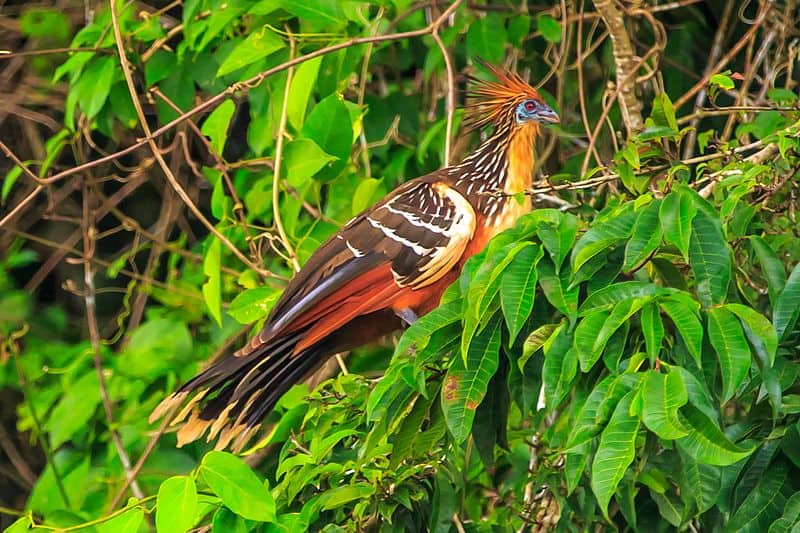Hoatzin Facts
- This remarkable winged wonder is most frequently referred to by the deceptively simple common name of Hoatzin. Yet, it also has a host of other general titles by which it’s known. These include such terms as stinkbird, reptile bird, Canje Pheasant.
- Within the scientific community, however, it’s perhaps better known by its technical moniker. Unfortunately, that’s an extremely difficult appellation for the layperson to pronounce. That’s because it holds the formal tag of Opisthocomus hoazin.
- The intriguing avian received this tongue-twisting epithet due to the efforts of Philipp Ludwig Statius Müller. The respected German zoologist achieved the first recognition of it as a separate and distinct species. He managed that notable feat in 1776.
- It’s noted for two unique reasons. It has the well-deserved, if most unflattering, reputation of exuding a strong manure-like odor. For the moment, there also remains no clear picture for scientists of the evolutionary path of this animal to the present.
- Thankfully, the fascinating Hoatzin appears to be maintaining a population base that’s both stable and sufficient. That pleasant state further seems to hold true across its native range. The IUCN therefore presently shows it as Least Concern on its Red List.
- The marvel of Nature nevertheless does face several potential threats to its continued existence as a species, at least. Like all creatures alive today, most of these stem from the actions of mankind. They include, among others, habitat loss and climate change.
Related Articles
Tawny Frogmouth
Hoatzin Physical Description
The highly distinctive Hoatzin rarely fails to capture the attention of those who encouter it. This naturally occurs for a wide variety of reasons, from its unusual scent to its remarkable appearance. Either way, it’s a masterpiece of evolution to be fully appreciated.
It differs from many species around the world in another way, too. That’s in the fact that it displays virtually no discernible degree of the physiological characteristic of sexual dimorphism. Distinguishing the genders as a casual glance therefore becomes quite difficult.
Collectively, both genders attain a roughly medium-size for birds. Their total average body length ranges from approximately 22 – 26 in (55 – 65 cm). Weights vary, sometimes significantly, but a mean measurement for this equals roughly 12 – 23 oz (0.35 – 0.65 kg).
The neck of this scientifically magnificent bird grows elongated, and the head stays relatively small. The face iself, though, appears devoid of feathers. The species also remains noted for its bright maroon colored eyes. Atop the head also sits a fairly large spiky crest.
The tail also grows long and broad, while the wings and back typically show a dark shade of brown. The underside most frequently displays striking combinations of off-white and chestnut in color, making for a remarkably striking appearance for the animal.
One unexplained evolutionary trait of the Hoatzin, however, continues to mystify and amaze most researchers. Though they disappear shortly after birth, the hatchlings are actually born possessing small claws on the wing digits. It’s physically unique among modern birds.
- Kingdom: Animalia
- Phylum: Chordata
- Class: Aves
- Order: Opisthocomiformes
- Family: Opisthocomidae
- Genus: Opisthocomus
- Species: O. hoatzin
Hoatzin Distribution, Habitat, and Ecology
The mind-boggling Hoatzin evolved as native to a moderately broad swathe of the earth’s surface. Given its exotic nature, however, the location of that zone of habitation likely won’t surprise many people. That’s because it developed as native to a portion of South America.
There, this remarkable bird makes its home primarily within the confines of the Amazon Basin. Given the vast expanse of that territory, though, this includes a number of countries. Some of these include Brazil, Ecuador, Peru, Colombia, Venezuela, Guyana, and Bolivia.
Like many species, it displays decidedly strong preferences regarding its choice of habitat type. Its distribution remains largely confined to the tropical and subtropical forests and swamps of the Amazon and Orinoco river basins, as well as parts of the Guianas.
Within these regions, though, the distinctive creature typically inhabits areas sharing certain traits. These consist of sections of moderately dense riparian forests, flooded forests, and sometimes mangrove swamps near water bodies such as rivers, lakes, and ponds.
Having evolved as principally herbivorous in nature, the remarkable Hoatzin feeds primarily on the plentiful leaves of plants native to its specific habitat. Yet, the fascinating animal also occasionally feeds on the typically plentiful fruit and flowers of the same species.
Despite the relatively large wings the animal possesses, the mystifying avian remains a poor flier, somewhat to the surprise of scientists. It also remains quite clumsy on the ground, generally moving quite awkwardly. The bird also possesses a generally mild temperament.
Species Sharing Its Region
Check out our other articles on Long Eared Owl, Snowy Owl, Albatross, 7 Bizarre and Unusual Birds, Kuang Si Falls, Great Hammerhead Shark, Jewel Caterpillar, Orinoco Crocodile

